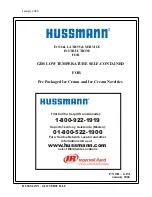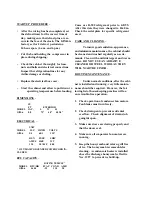
INTRODUCTION –
The Gim-6 is a low temperature,
self-contained cabinet designed for pre-
packaged ice cream or ice cream novelties
at below freezing temperatures. Design
features include self-closing glass doors,
efficient foamed in place non-CFC ins ula-
tion, low rail height, from both sides, and
a balanced refrigeration system for en-
ergy saving performance
INSPECTION –
Upon receipt of the cabinet, care-
fully examine the crating for damage. If
crate is damaged, make a note on the de-
livery ticket before signing. Carefully re-
move shipping crate and examine cabinet
for “concealed” damage. If damage is
found, contact the delivery carrier imme-
diately and have his agent prepare an in-
spection report for the purpose of filing a
claim. THIS IS Y OUR RESPONSIBIL-
ITY.
LOCATION –
Avoid locating the case where di-
rect sunlight would shine into the fixture
or where drafts from air conditioning
grills, fans, and open doors could effect its
operation.
CLEARANCE –
Because this condensing unit is
located at the bottom of the cabinet, a
three (3) foot clearance should be allowed
in front of the louvered access panel to
provide free air movement to and from
the condenser for maximum operating ef-
ficiency.
INSTALLATION and START-UP –
SKID –
The skid should be left on the unit
until it is near its final location. The skid
provides protection for both cas e and
floor. The skid is removed by removing
the bolts holding the skid clamps to the
case base, then sliding the cas e off the
skid. A “mule” bracket is built in the end
of the cabinet base frame for this purpose.
LEVELING and SEALING –
Proper drainage of the evaporator
condensate water requires the cabinet to
be properly leveled. This means left to
right as well as front to back.
The case can be leveled using the
leveling screws in the bottom of the case
or by shimming under the cabinet base
frame. The self-closing doors require the
cabinet to be properly leveled. End to end
leveling will make the doors close with
uniform speed and tightness. Once level
the case should be sealed to the floor as
shown in the following drawing, using an
NSF approved material such as General





































